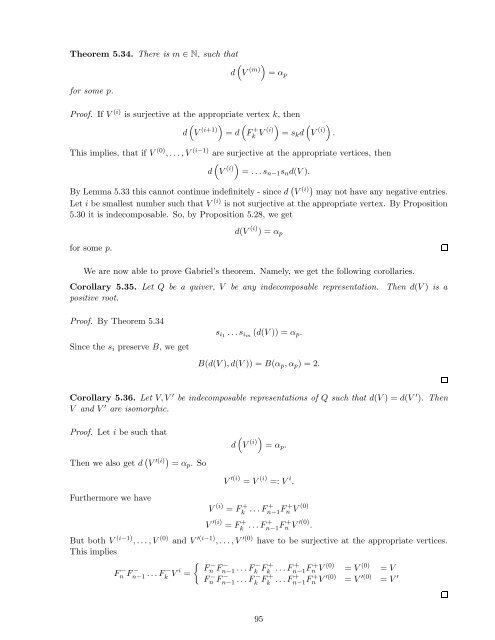Lecture notes for Introduction to Representation Theory
Lecture notes for Introduction to Representation Theory
Lecture notes for Introduction to Representation Theory
You also want an ePaper? Increase the reach of your titles
YUMPU automatically turns print PDFs into web optimized ePapers that Google loves.
Theorem 5.34. There is m N, such that<br />
<br />
d V (m) = ϕ p<br />
<strong>for</strong> some p.<br />
Proof. If V (i) is surjective at the appropriate vertex k, then<br />
V (i+1) F + V (i) V (i)<br />
d = d<br />
k<br />
= s k d .<br />
This implies, that if V (0) , . . . , V (i−1) are surjective at the appropriate vertices, then<br />
<br />
d V (i) = . . . s n−1 s n d(V ).<br />
By Lemma 5.33 this cannot continue indefinitely - since d ⎩ V (i) may not have any negative entries.<br />
Let i be smallest number such that V (i) is not surjective at the appropriate vertex. By Proposition<br />
5.30 it is indecomposable. So, by Proposition 5.28, we get<br />
<strong>for</strong> some p.<br />
d(V (i) ) = ϕ p<br />
We are now able <strong>to</strong> prove Gabriel’s theorem. Namely, we get the following corollaries.<br />
Corollary 5.35. Let Q be a quiver, V be any indecomposable representation. Then d(V ) is a<br />
positive root.<br />
Proof. By Theorem 5.34<br />
Since the s i preserve B, we get<br />
s i1 . . . s im (d(V )) = ϕ p .<br />
B(d(V ), d(V )) = B(ϕ p , ϕ p ) = 2.<br />
Corollary 5.36. Let V, V be indecomposable representations of Q such that d(V ) = d(V ). Then<br />
V and V are isomorphic.<br />
Proof. Let i be such that<br />
<br />
d V (i) = ϕ p .<br />
Then we also get d ⎩ V (i) = ϕ p . So<br />
Furthermore we have<br />
V (i) = V (i) =: V i .<br />
V (i) = F + . . . F + F + V (0)<br />
k n−1 n<br />
V (i) + +<br />
= F k<br />
. . . F n −1 F n<br />
+ V (0) .<br />
But both V (i−1) , . . . , V (0) and V (i−1) , . . . , V (0) have <strong>to</strong> be surjective at the appropriate vertices.<br />
This implies<br />
<br />
Fn − F − . . . F − F + . . . F + F<br />
+<br />
n<br />
= V<br />
F − F − . . . F − V i =<br />
n−1 k k n−1 V (0) = V (0)<br />
n n−1 k<br />
F − −<br />
n F n−1 . . . F − + +<br />
k<br />
F k<br />
. . . F + n V (0) = V (0) = V <br />
−1 F n<br />
95

















